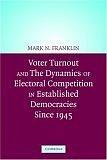| Listing 1 - 1 of 1 |
Sort by
|

ISBN: 9780521541473 9780511616884 9780521833646 9780511210402 051121040X 0521833647 0521541476 0511213980 9780511213984 0511215770 9780511215773 0511616880 1280540834 9781280540837 0511212178 9780511212178 9786610540839 6610540837 9780511314827 0511314825 051121040X 0521833647 0521541476 1107149274 Year: 2004 Publisher: Cambridge ; New York : Cambridge University Press,
Abstract | Keywords | Export | Availability | Bookmark
 Loading...
Loading...Choose an application
- Reference Manager
- EndNote
- RefWorks (Direct export to RefWorks)
Voting is a habit. People learn the habit of voting, or not, based on experience in their first few elections. Elections that do not stimulate high turnout among young adults leave a 'footprint' of low turnout in the age structure of the electorate as many individuals who were new at those elections fail to vote at subsequent elections. Elections that stimulate high turnout leave a high turnout footprint. So a country's turnout history provides a baseline for current turnout that is largely set, except for young adults. This baseline shifts as older generations leave the electorate and as changes in political and institutional circumstances affect the turnout of new generations. Among the changes that have affected turnout in recent years, the lowering of the voting age in most established democracies has been particularly important in creating a low turnout footprint that has grown with each election.
Voter turnout --- Political participation --- Democracy --- Election turnout --- Turnout (Voting) --- Voting turnout --- Voting --- Citizen participation --- Community action --- Community involvement --- Community participation --- Involvement, Community --- Mass political behavior --- Participation, Citizen --- Participation, Community --- Participation, Political --- Political activity --- Political behavior --- Political rights --- Social participation --- Political activists --- Politics, Practical --- History --- Polls --- Elections --- Social choice --- Suffrage --- Vote --- Participation politique --- Démocratie --- Histoire --- Political sociology --- Political systems --- anno 1900-1999 --- anno 2000-2009 --- Social Sciences --- Political Science
| Listing 1 - 1 of 1 |
Sort by
|

 Search
Search Feedback
Feedback About
About Help
Help News
News